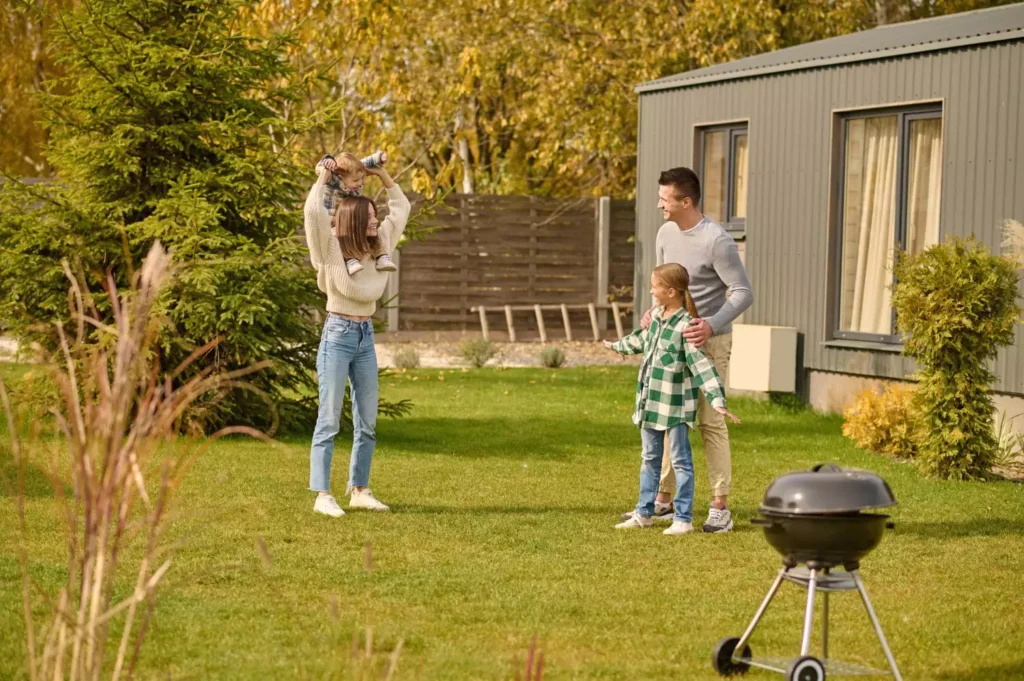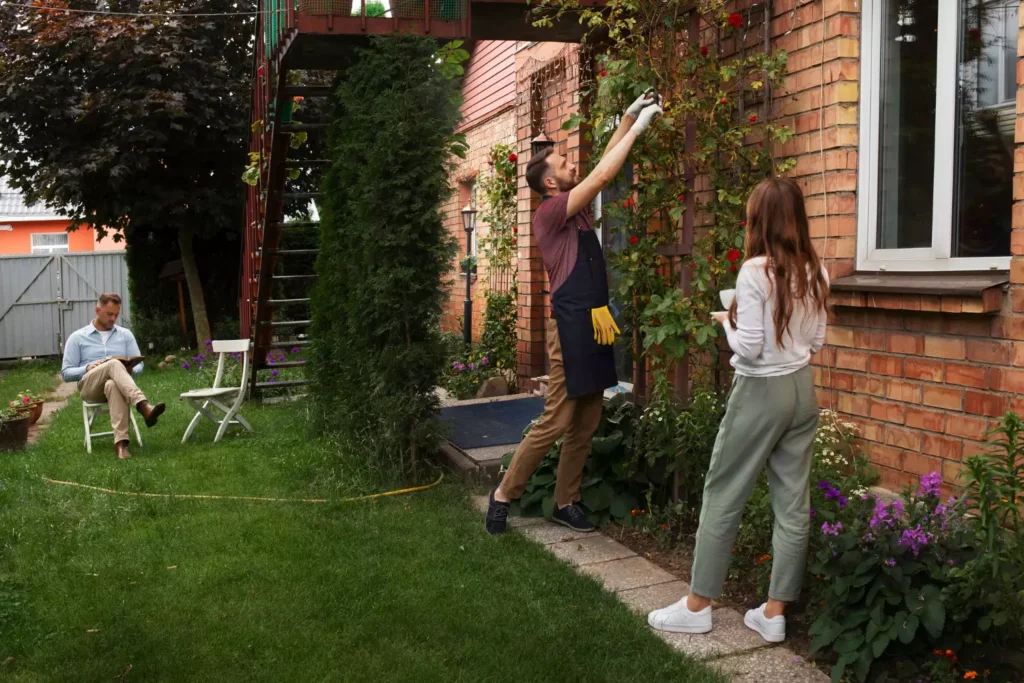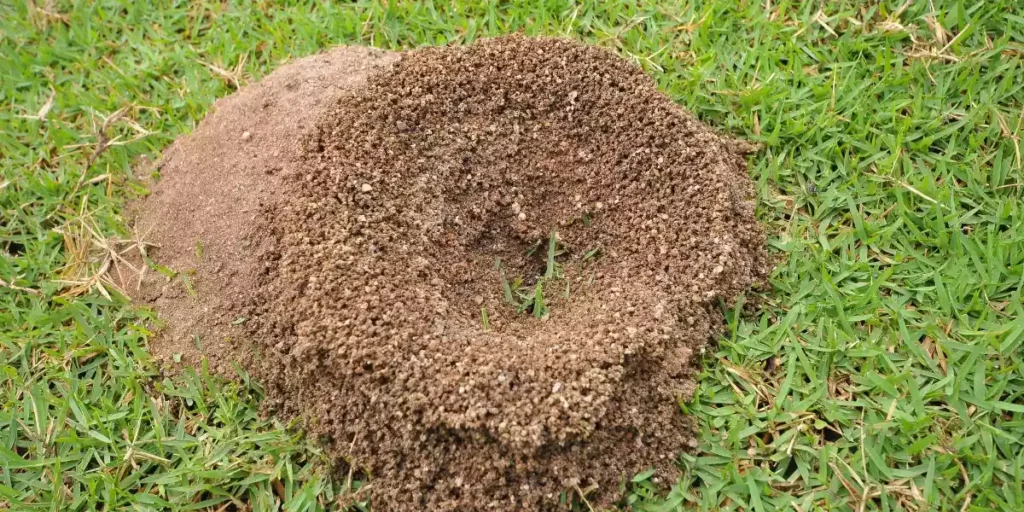Aerating your lawn is an important part of lawn care that can provide numerous benefits. It can help your lawn stay healthy and look its best.
You may be wondering how to aerate your lawn, and luckily it’s not too difficult. In this article, we’ll be discussing the steps necessary to aerate your lawn properly and safely.
We’ll cover why aeration is important, when to do it, how to do it, and what to do afterwards. So, let’s get started and learn how to aerate your lawn properly!
Why Aerate Your Lawn?
Got a patchy, bumpy lawn? Aeration could be the answer to get it looking lush and level again!
Aerating your lawn can help reduce lawn compaction, promote healthy root development, and increase water, nutrient and oxygen intake. Compacted soil is caused by foot traffic and can lead to a shallow, unhealthy root system. Aeration helps reduce compaction by removing small plugs of soil from the ground, which allows air, water, and nutrients to penetrate the soil more easily.
Aeration also allows water to penetrate deeper into the soil, which helps create stronger root systems and a healthier lawn. By aerating your lawn, you can reduce the compaction that has been caused by activities such as mowing, sports, and other recreational activities.
The result of aeration will be a healthier, lush lawn that is better able to absorb water and nutrients, and is less likely to be damaged or stressed by foot traffic.
When to Aerate the Lawn?
Don’t wait too long to give your grass the breath of fresh air it needs! Aerating your lawn is essential for a healthy, lush lawn. It helps reduce soil compaction, improves the soil structure and allows nutrient-rich oxygen, water, and fertilizer to penetrate the soil.
Generally, it’s recommended to aerate your lawn at least once a year, ideally in the spring or fall. Here are a few tips to help you decide when to aerate your lawn:
- Aerate when the soil is moist and not too dry or too wet.
- Aerate when the grass has had time to grow and is at least three inches tall.
- Aerate when the temperature is above 60 degrees Fahrenheit.
How to Aerate a Lawn by hand?
Aerating your lawn by hand is a great way to get the job done. You can choose from a variety of manual aeration methods, such as aerator shoes, handheld aerators, and manual drum aerators. Each of these tools will effectively aerate your lawn, so just pick the one that works best for you.
Adjust the paragraph structure in the Input to logically group complete sentences on their own lines, with a double new line after. Use contractions.
Aerator shoes
You can give your grass a little extra TLC with aerator shoes – a simple and easy way to give your lawn a boost! Aerator shoes are a great way to aerate your lawn without the need for expensive equipment or manual labor.
They’re designed to penetrate the soil and create small holes that allow air, water, and nutrients to reach the roots of your grass. The shoes are easy to use and can be worn while walking around your lawn. They’re also lightweight and comfortable, making them a great choice for those who don’t want to spend a lot of time aerating their lawn.
Aerator shoes are a great way to keep your lawn healthy and looking its best. They’re also a great way to save time and money, as they don’t require any special equipment or manual labor. With aerator shoes, you can give your lawn the extra care it needs without breaking the bank.
Handheld aerators
Handheld aerators give you the power to quickly and easily give your grass the extra attention it needs. With a handheld aerator, you can easily reach areas of your lawn that may be difficult to access with an aerator shoe.
Here are some of the benefits of using a handheld aerator:
- It’s lightweight and easy to use.
- It can be used to aerate small areas of your lawn.
- It’s more affordable than other aeration methods.
Manual drum aerators
Manually drum aerating is a great way to give your grass the extra TLC it needs, and it’s easy to do! Drum aerators are a manual tool that you can use to aerate your lawn in just a few simple steps.
These tools are typically pushed into the soil using your feet, which helps to break up the soil and create small holes. This allows air, water, and fertilizer to penetrate the soil more easily, which in turn helps to stimulate root growth and keep the lawn healthy. The manual drum aerator also helps to reduce compaction of the soil, which can otherwise lead to an unhealthy lawn.
It’s important to note that manual drum aerators can only be used on small to medium sized lawns due to the amount of effort required to push them into the ground. However, they are still a great option for those who prefer to aerate their lawns by hand.
Powered Types of Aerators
You’re ready to take your lawn care to the next level? Powered aerators are just the tool you need.
Spike aerators, slicing aerators, and core or plug aerators are the three main types of powered aerators that will help you get the job done quickly and effectively.
All three are designed to reduce soil compaction and improve water, oxygen, and nutrient uptake for your lawn.
Spike aerators
A spike aerator is a great way to give your lawn a much-needed boost, and it’s simple to use – no need to break a sweat! Spike aerators are a type of lawn aerator that use a series of spikes to penetrate the soil and create small holes. This allows air, water, and nutrients to reach the roots of the grass, promoting healthy growth.
Here are some of the benefits of using a spike aerator:
- Improved air circulation: Spike aerators create small holes in the soil, allowing air to reach the roots of the grass.
- Increased water absorption: Spike aerators create channels for water to reach the roots of the grass, promoting healthy growth.
- Reduced soil compaction: Spike aerators break up compacted soil, allowing the grass to grow more freely.
Spike aerators are a great way to give your lawn a much-needed boost and promote healthy growth. With a few simple steps, you can easily aerate your lawn and enjoy a lush, green lawn all year round.
Slicing aerators
Slicing aerators are a great way to give your grass a breath of fresh air and help it reach its full potential – after all, you reap what you sow!
Unlike spike aerators, slicing aerators pull small pieces of soil plugs out of the ground, which help to open up pathways for air and water to get to the roots.
Slicing aerators are especially helpful for lawns that have a lot of thatch, as they can effectively help to reduce it. Additionally, slicing aerators are ideal for compacted soil, as they can break up the hard soil and help to reduce compaction.
They can also help to break up any soil clumps, ensuring that your grass has the best chance of growing healthy and strong.
Core or plug aerators
Try core or plug aerators for an effective way to give your grass the nutrients it needs! Core aerators remove a core of soil from the lawn, allowing water, air, and nutrients to penetrate the root zone. Plug aerators pull out a plug of soil, creating a hole that is left on the ground and then filled with the removed soil.
Both of these aeration methods work well to improve soil drainage and give the grass the nutrients it needs. Here are four benefits of core and plug aerators:
- They reduce soil compaction.
- They promote deeper root growth.
- They increase air flow and water absorption.
- They allow for the use of fertilizers and other nutrients.
By using core or plug aerators on your lawn, you’ll give your grass the nutrients and oxygen it needs to thrive and stay healthy.
The Basics of lawn aeration
Before you start aerating your lawn, it’s important to make sure the ground is prepped properly. Mow the grass short before aerating and water the lawn a few days before.
When you’re ready to start aerating, use a lawn aerator to create small holes in your lawn. Then, spread grass seed over the area. Finally, water the seeded area after aerating to ensure the seed has enough moisture to grow.
Prepare your lawn
Mowing your lawn regularly is a great start to preparing your lawn for aeration. To make sure your lawn is fully prepped, you should then scarify it and mow again to pick up all debris.
Finally, if the soil is dry, make sure you water the lawn before aeration to get the best results.
Mow your lawn
Cut your grass short and even to get it ready for aeration.
Mow regularly and keep your grass blades between 2-3 inches tall. This will ensure that the aeration process penetrates the soil more deeply, allowing the roots to access more water and oxygen.
Additionally, keeping your grass short helps prevent scalping, which is when the lawn becomes uneven due to the aeration process.
Finally, mowing regularly encourages a healthy, lush lawn and helps decrease the build-up of thatch, a layer of organic material that can prevent water from reaching the roots.
Scarify your lawn
After mowing your lawn, it’s time to scarify it. Scarifying is an important step in aerating your lawn. It removes excess thatch build-up that can otherwise prevent oxygen, water, and nutrients from reaching your grass’s roots.
Scarifying your lawn can be done with a mechanical or manual rake. It is best done in the spring or fall when the soil is moist. Try to avoid scarifying during periods of drought, as this can damage your lawn.
Always be sure to rake away clippings and debris after you’re done.
Mow again and pick up all the debris
After you’ve scarified your lawn, it’s time to mow it again and pick up all the debris. The clippings, like a million tiny pieces of art, will make your lawn look like a masterpiece.
Mowing your lawn again will help to break up any remaining debris and will also help to make sure that the seed you’ve planted is evenly distributed. Once you’ve finished mowing again, make sure to pick up all the clippings and debris so that your lawn looks neat and tidy.
water the lawn if the soil is dry
Watering your turf, if the soil is dry, can help ensure that the grass seed you’ve planted takes root and grows lush and healthy. This is important because it helps to promote the growth of healthy, strong roots.
Watering should be done thoroughly and deeply, as shallow watering can lead to a shallow root system. It’s best to water the lawn early in the morning to allow time for the water to be absorbed and avoid the water evaporating in the heat of the day.
Additionally, you should water the lawn slowly and evenly to ensure that the soil is receiving adequate hydration. This will help to prevent the soil from becoming too dry and compacted, which can inhibit the growth of healthy grass.
What to do during aeration?
When you aerate, it’s important to take the time to ensure the job is done right. Why not use this opportunity to give your lawn some extra TLC?
First, be sure to mow the lawn at its lowest recommended setting. This helps to create a surface that is more conducive to aeration.
Next, use a mechanical or hand aerator to puncture the soil. This will allow water, air, and nutrients to penetrate deeper into the soil. If possible, aerate the lawn in several directions. This will help to open the soil more evenly across the entire surface of the lawn.
Finally, apply a fertilizer and/or seed to help your lawn heal and recover from the aeration process. Doing so will also help to give your lawn the nutrients it needs to stay healthy and vibrant.
What to do after aeration?
Now that you’ve created the perfect environment for your grass to thrive, give it the nourishment it needs to really take off! Give it a good watering and watch it come alive.
After aerating, it’s important to fertilize the lawn to help promote root growth and create a lush, green lawn. Here are some tips to consider when fertilizing your lawn:
- Use a fertilizer that’s suited to the type of grass in your lawn.
- Avoid using too much fertilizer, as it can burn the grass and damage the soil.
- Apply the fertilizer evenly over the entire lawn for the best results.
By fertilizing your lawn after aeration, you’ll help it to develop a strong root system and grow strong and healthy. Additionally, it’s important to regularly water and mow your lawn in order to maintain a healthy and vibrant lawn.
When Lawns Need Aeration?
If the soil in your yard feels hard and compacted, it’s time to give it some breathing room! Aeration is an important part of lawn care that can help reduce compaction and improve the health of your grass.
The best time to aerate your lawn is when it’s actively growing, usually during the spring and fall seasons. If your soil is compacted, aeration can help loosen it up so that water, air, and nutrients can better penetrate the roots. Additionally, aeration helps reduce thatch build-up and increase the size of root systems.
If your lawn experiences heavy foot traffic, you may need to aerate more often. Aerating your lawn every other year is usually enough to keep it healthy and looking its best.
What to Do After Aeration?
After aerating, make sure you give your lawn the attention it needs to stay healthy and beautiful. This includes watering, fertilizing, and mowing regularly. To ensure your lawn stays in top condition, here are some tips to follow:
- Water your lawn deeply and infrequently to promote deep root growth.
- Fertilize your lawn at least four times a year, but be sure to follow the instructions on the fertilizer packaging.
- Mow your lawn regularly to allow for even growth and to encourage healthy grass.
- Remove any weeds that are present in your lawn and use an appropriate herbicide to prevent them from coming back.
What is the best way to aerate a lawn?
Aerating is an essential step to keep your lawn healthy and lush, so it’s important to know the best way to do it! The best way to aerate a lawn is to use a spike aerator. This type of aerator uses a cylinder with spikes that punch holes into the soil.
The depth of the holes depends on the length of the spikes, so make sure you choose an aerator with the right length for your lawn. For best results, aerate your lawn in the spring or fall when the soil is moist. This will ensure that the holes made by the aerator are deep enough to loosen the soil and promote healthy root growth.
If you aerate your lawn regularly, it will be greener and healthier and will require less maintenance.
What happens if I don’t aerate my lawn?
You may be wondering what happens if you don’t aerate your lawn. The truth is, not aerating your lawn can cause a number of problems.
Over time, the grass on your lawn will become more compacted due to regular foot traffic, heavy rain, and other activities. This can prevent oxygen, water, and nutrients from reaching the roots of the grass. Without these essential elements, the grass on your lawn will begin to thin out and become unhealthy.
Additionally, the thatch layer of your lawn, which is made up of dead grass and other debris, can become too thick. This can lead to increased weeds and pests in your lawn. Without regular aeration, an unhealthy lawn is almost certain.
Can I aerate my lawn with a pitch fork?
A pitchfork might seem like an attractive option for dealing with a compacted lawn, but it can’t compare to the effectiveness of specialized aeration equipment. It’s important to understand that a pitchfork does not penetrate deep enough into the soil to make the same kind of positive impact that an aeration machine can.
Here are some key points to consider:
- A pitchfork does not reach deep enough into the soil to make a significant difference in the soil’s structure.
- The tines of a pitchfork are not sharp enough to penetrate compacted soil.
- A pitchfork will not be able to break up large chunks of soil that may be present.
Therefore, while a pitchfork may be useful for removing weeds or other surface debris, it is not a suitable tool for aerating your lawn. For the best results, it’s recommended to use a specialized aeration machine.
Conclusion
You’ve now learned how to aerate your lawn properly and safely. Taking the time to aerate your lawn is an investment in your home’s beauty and longevity.
Aerating your lawn helps promote better air exchange and water absorption, which will help keep your grass looking lush and vibrant. So don’t be afraid to roll up your sleeves and get to work aerating your lawn; it’ll be worth it in the long run.
Think of it as putting the sparkle back into your lawn—like a breath of fresh air!




